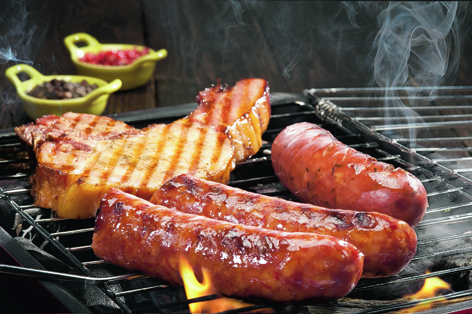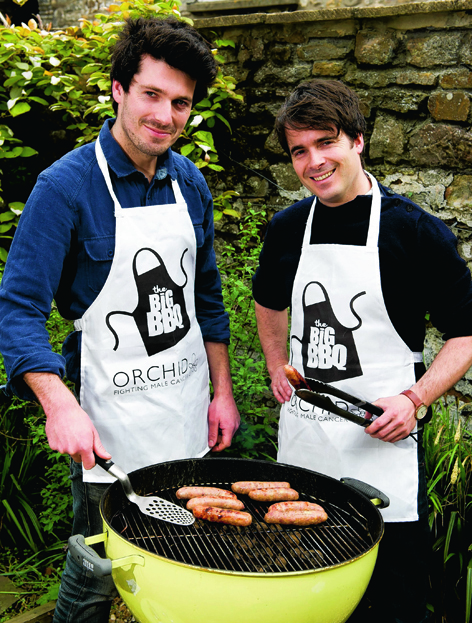Barbecues are a summer highlight – but make sure you don’t sizzle your way to any health hazards. We grill the experts
Chomping into juicy burgers at summer barbecues, few people will spare a thought for the health risks of al fresco dining.
Food poisoning cases double over the summer, with barbecues playing a significant role. But nasty bacteria lurking in undercooked drumsticks or gone-off hot dogs isn’t the only reason to operate some grill-side caution – barbecued food can sometimes be carcinogenic too.
Cancer Research UK warns that when red and processed meats are cooked at very high temperatures, such as on a barbecue, cell-damaging chemicals are made. This damage makes cells more likely to become cancerous.
Plus, processed meats have been linked to colorectal and lung cancers, notes the male cancer charity Orchid, which also points out that well-done, flame-grilled red meat is associated with compounds that may increase the risk of colorectal, prostate and pancreatic cancers.
Of course, barbecues are fun and there’s no reason to stop enjoying them. As nutritionist Sarah West points out: “It’s important to remember that we don’t barbecue every day. Red meat is a great source of nutrients such as protein, iron, B vitamins and zinc, and the occasional grilled sausage is unlikely to put you at risk as part of wider healthy balanced diet.”
So there’s no need to ban barbecues, but a few little tweaks here and there could help ensure your al fresco feasts don’t pose too much of a health threat.
Orchid’s BIG BBQ campaign is encouraging people to help raise awareness of male cancers when they fire up the grill this summer, and raise funds in the process. The charity’s teamed up with a host of celebrity chefs, including Gordon Ramsay, Heston Blumenthal, MasterChef winner Natalie Coleman, Hugh Fearnley-Whittingstall and The Fabulous Baker Brothers, who are all lending their support and donating recipes, which can be found on the campaign’s website.
Rebecca Porta, Orchid’s chief executive, warns that every year in the UK, 43,000 men are diagnosed with a male-specific cancer, yet blokes can be notoriously bad at taking their health seriously, or going to see their doctor about symptoms.
Summer shindigs can be a great way for men to open up, though – a recent survey by the charity revealed that a third of men find it easier to confide in one another when standing around the barbecue.
“So fire up the grill and help us to get men talking,” says Porta. “We urge men to take this opportunity to think about their health this summer.
“The BIG BBQ initiative aims to get men fired up about their health, and encourage them to get together with family, friends and colleagues to help raise much-needed awareness and funds for male cancers.”
West has helped Orchid devise this list of simple tips for a more health-conscious barbecue:
Lowering the barbecue temperature or elevating the grill to avoid burning food may help, as flame-grilling meat at high temperatures releases chemicals called heterocyclic amines (HCA) that have been linked to cancer.
Covering meat in an antioxidant-rich marinade before grilling can reduce the potentially carcinogenic properties of even well-done meats. Incorporating various herbs and spices, such as rosemary and thyme, in a marinade can help reduce HCAs by as much as 87%.
Carcinogenic chemicals can also form in the smoke produced by dropped meat fat and juices, so trimming excess skin and fat will ensure less harmful smoke. Wrapping meat in foil also helps.
Clean the grill, as removing charred bits of food will help prevent chemicals building up and transferring onto food. Lightly oiling the grill before cooking will also help prevent burning and sticking.
Try pre-cooking meat in the oven before finishing it outside on the barbecue, as less time on the grill means less exposure to potentially carcinogenic chemicals.
Pairing grilled meats with vegetables, like broccoli, cauliflower and kale, will add an additional cancer-fighting punch, as they contain a compound that has been shown to target and block a defective gene associated with cancer.
If you’re prone to overdoing the amount of barbecued red meat you eat – 500g of red or processed meat (equivalent to one steak, one pork chop and three sausages) is considered a healthy weekly allowance – follow up with a few meat-free days to help balance things out.
To download a BIG BBQ event pack, including celebrity recipes and party game ideas, visit www.the-big-bbq.co.uk
A SAFER SIZZLE
The main health risk associated with barbecues is food poisoning. Campylobacter, salmonella and E.coli are the main food poisoning bugs, causing symptoms like severe stomach cramps, sickness and diarrhoea.
Though food poisoning is very common and often clears up by itself fairly quickly, it can also sometimes be very serious.
British Dietetic Association spokeswoman Lucy Turnbull says the best way to avoid such barbecue nasties is by following simple food hygiene practices, and ensuring barbecued meat is fully cooked.
She suggests using separate chopping boards and knives for meat and non-meat foods, and never handling raw meat without washing your hands afterwards, and before touching anything else.
“Wash utensils before using them with different foods, use separate cloths to wash chopping boards, and keep foods as separate as possible,” she advises.
“With a barbecue, we’re always going back and forth and touching different things, so making sure food contamination is reduced is really important.”
It’s also vital to keep raw meat separate from other foods beforehand, and don’t let the meat juices, which could contain bacteria, drip down onto other foods in the fridge.
It may also be worth turning the fridge up a little before the barbecue, as it’ll probably be opened more often than usual which can increase the temperature.
“Make sure food is cooked through – it can be quite difficult on a barbecue to judge if the middle’s cooked,” says Turnbull. “This is especially important for chicken, and processed meat like burgers and sausages.
“Things like lamb and beef joints can be slightly rare, because there’s less chance that the middle’s been contaminated with bacteria. But when meat is processed, there’s a chance the middle could be contaminated, so you want to make sure it’s cooked through so any germs or bacteria are killed.”
Turn food frequently to help cook it evenly, and make sure burgers, sausages and chicken are properly cooked by cutting into the meat and checking that it’s steaming hot all the way through, that none of it’s pink and that any juices run clear.
Cooking meat in the oven before bunging it on the barbecue is also a good idea. “If you pre-cook the meat, a lot of the fat drains off,” says Turnbull. “You can crisp off the edges on the barbecue, so you’re still getting the flame-grilled flavour but it’s safer.”

